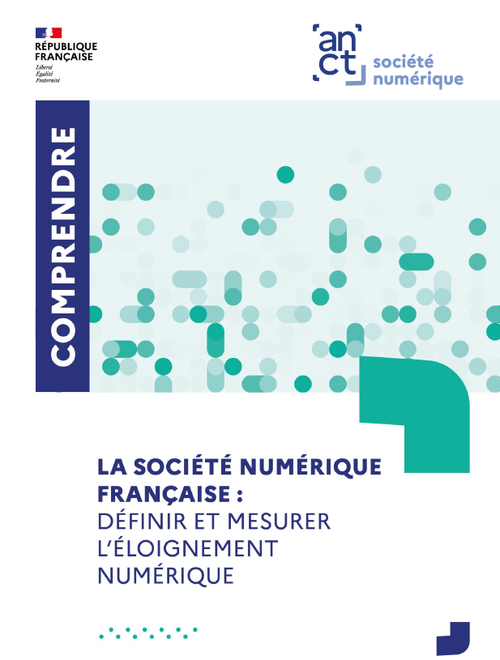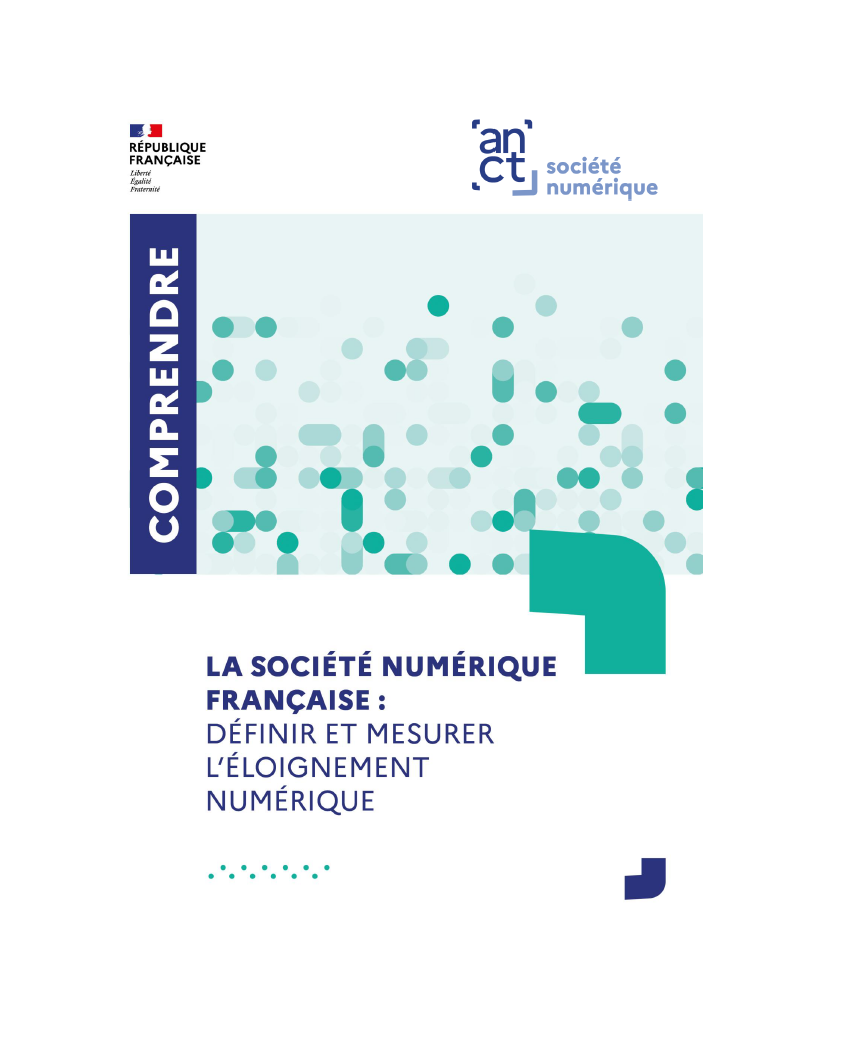
Foreword
In 2021, the Digital Society Program of the National Agency for Territorial Cohesion (ANCT), launched a consultation for the production of a report on the state of the art of the French digital society. The Centre de Recherche pour l'Étude et l'Observation des Conditions de Vie (CRÉDOC) and the Centre de Recherche sur l'Education, les Apprentissages et la Didactique de l'Université de Rennes (CREAD), associated with the GIS M@rsouin, have been entrusted with the production of this report. For this first edition, the ANCT chose to focus on the definition of digital distance, the comparative analysis of its different measures, and the identification of the main associated factors.
The purpose of this article is to summarize this work.
A paradigm shift is needed to define digital distance
Historical approaches
Initially, as early as the 1990s, digital remoteness was defined through the prism of access to technologies ( technocentric approach), giving rise to the concept of the "digital divide", at a time when such access was still the prerogative of educated, urban and high-income individuals (Pasquier, 2022). Then, in the early 2000s, a skills-based approach was popularized, giving rise to the concept of "digital literacy", which testifies to the growing attention paid to the issue of digital technology usage. Digital inequalities between individuals are explained by a differential in appropriation and use induced by different skill levels (Erstad 2010).
While these angles of approach can be useful in providing an overview of the spread of digital technologies and skills in society, they are only a partial way of analyzing the phenomenon of digital estrangement. This is all the more true in a French society that in recent years has seen a massive spread of THD Internet access as well as digital equipment and usage within the population (Crédoc, 2022). On the other hand, having access to digital tools and the necessary skills to use them correctly are necessary, but not sufficient, conditions for improving the day-to-day life of an individual or group. For digital technologies to be appropriated, the potential user must perceive a positive "meaning of use", i.e. a feeling of usefulness or identity (Pitaud and Deschamps, 2021).
A new generation of studies has then focused on the differentiated capacities of individuals to benefit from these uses, questioning the existing links between digital skills, Internet use and concrete benefits.
The concept of digital capability, or how to move away from a dichotomous vision of digital inequalities
Over the last ten years, a new generation of studies has focused on the unequal potential of individuals to transform the opportunities (cultural, economic, social, political, etc.) offered by digital technologies into actual benefits (Ragnedda, 2017; Robinson et al., 2020a, 2020b). In this way, these works have reversed the traditional angle of approach, centered on lack (of access, of skills), to focus on the contribution of technologies for individuals. It is on this basis that the concept of " digital capability " has emerged. Capabilities are the set of actions that an individual has the power to implement, and the set of states that he or she can effectively achieve, in order to increase well-being and foster the power to act (Bacqué, 2013). This concept thus makes it possible to define digital remoteness beyond a dichotomous vision of digital inequalities (users/non-users; Internet users/non-Internet users). While the use of digital technologies is a priori likely to improve individual well-being, not all individuals are in a position to derive the same benefits from digital technologies. Indeed, various studies have shown that the enabling or disabling nature of digital technologies is in fact largely conditioned by people's living conditions (van Deursen and Helsper, 2015; van Deursen and van Dijk, 2014).
The concept of digital capability now provides an interesting way of thinking about the definition of digital remoteness, based on people's ability to use digital technology to enhance their well-being and promote their power to act. How, then, can we explain these differentiated capabilities? And so, who in France can be considered digitally remote these days?
Who in France are the most remote from digital technology, and why?
The age factor: dispelling preconceived ideas
Age is a variable often used to characterize digital alienation, with older people generally perceived as having the most difficulties with digital technologies, while, conversely, younger people are often seen as experts. However, age is by no means an explanatory factor in digital distance; at most, it is a descriptive factor.
A generational effect among seniors
While many over-60s have gone online in recent years (Anderson and Kumar, 2019), one group stands out among seniors: the over-70s, who appear significantly less connected than the rest of the population. Thus, in 2022, 37% of people over 70 are not Internet users, compared with just 4% among people aged 60 to 69 (8% of the population as a whole, according to the Baromètre du numérique 2022). What's more, 71% of people aged 55 to 64 in 2012 were Internet users, whereas 97% of people in the same age bracket in 2022 were Internet users. In other words, today's "young retirees" are more connected than those 10 years ago. These figures highlight a generational effect, and there are several reasons for this. Firstly, seniors discovered the Internet late in life (Pasquier, 2022): 70% of them went online for the first time at the age of 70 (Crédoc, 2019). Some of them have therefore worked in professional sectors that do not require the use of digital technology (Facchini, 2021). The use of digital technologies has indeed increased significantly over the last ten years, while the over-70s have, as a rule, left the labor market before this generalization. What's more, the 70+ age group is the one with the highest number of people without any qualifications, who did not experience the massification of schooling in their youth. Without calling into question the existence of specific age-related difficulties, this analysis by year of birth qualifies them. It is possible that in the future, age will be less and less of a factor, as the generations who discovered digital tools at a later stage are gradually replaced.
The myth of the digital natives
Despite using the Internet more intensively than their elders, digital use among young people does not guarantee expert use of these technologies (Cordier 2020). This observation runs counter to the idea that there are "digital natives", which conveys the idea that young people - born into a digital society, unlike older generations - have de facto mastered digital technologies, their codes and related uses. However, a large body of research shows that young people's digital skills and practices are differentiated, heterogeneous and, above all, unequal, insofar as they depend on very different social contexts (Hargittai and Hinnant, 2008; Livingstone, Bober and Helsper, 2005). For example, many young people, particularly those from low-income backgrounds, encounter difficulties in their use of digital technology, for example when searching for jobs online or completing administrative procedures, for a variety of reasons ranging from the cost of computer equipment to a lack of confidence in their ability to learn about and train with online tools (Deydier, 2018). Having become a commonplace disseminated by media discourses as a "concept-slogan" (Lardellier, 2017), the idea of "digital natives" constitutes a myth (Plantard, 2015a). Unfortunately, this still permeates collective imaginations, including those of young people themselves: some of them in fact incorporate the idea that they are supposed to be digital experts, provoking a sense of guilt in some of those who feel uncomfortable with digital tools (Cordier, 2015).
Social background and level of education, key factors of understanding
In reality, it is impossible to identify those who are far removed from the digital world without taking social and cultural factors into account. Socio-economic category is a variable in digital inequality, which tends to show that people from modest backgrounds are more likely to be distant from the digital world. In other words, in line with the concept of digital capability (see above), people from privileged backgrounds are more likely to derive tangible benefits from their use of digital technologies.
To explain digital distance even more precisely, other recent studies show a clear correlation between a low level of appropriation of digital technologies and a low level of cultural capital among individuals. Since the 2000s, as part of the massification of access to higher education, we have witnessed the emergence of a group of people, particularly from modest backgrounds, who have a level of university certification but are unable to find a job that corresponds to this certification. The consequence is the emergence, within modest categories, of publics sharing the same social background but differing in terms of diploma level (and therefore accumulation of cultural capital). In this context, studies have highlighted the existence of major differences in the appropriation of digital tools and practices, even within low-income groups, between individuals with diplomas and those with few or no diplomas, the latter being more marked by a digital estrangement. These studies demonstrate the central role played by people's cultural capital in terms of digital inequalities. The results of the Digital Barometer (2022) support these analyses: people with no qualifications are much less likely to be Internet users than those with at least the equivalent of a baccalaureate. The proportion of non-Internet users among the former is almost 40%, and less than 10% among the latter (and even 2% for university graduates). In short, while the interrelationship between the various factors mentioned suggests that they are often interdependent, the level of education (and, more broadly, cultural capital) appears to be a predominant factor in identifying and explaining digital distance within the French population.
Socially situated digital practices
In addition to the fact that individuals from the most advantaged social positions in society generally benefit from better quality access to digital resources, they also have a more diversified repertoire of practices (cf. educational, professional contexts, etc.) than individuals from modest backgrounds, who are more likely to use digital resources more for entertainment purposes. Moreover, the place of the written word is a determining factor in the different ways in which digital technologies are used. Indeed, low-income groups, particularly those with no formal education, distance themselves from the written word and devalue this form of exchange in favor of face-to-face interaction, even going so far as to adopt practices that circumvent the use of the written word. As a result, the digitization of administrative procedures exposes these low-income families to complex digital practices, which can exacerbate the phenomenon of non-use of the law in these environments if no alternative is offered to the digital channel.
A third of the French population is not digitally literate these days
How do you quantify digital distance?
Three survey systems have been used to quantify digital remoteness in France: Insee's household survey on the use of information and communication technologies, the Capacity and Capuni surveys conducted by the GIS M@rsouin, and the Digital Barometer commissioned by the French regulatory authority for electronic communications, post and press distribution (Arcep), the Conseil général de l'économie (CGE) and, more recently, the Autorité de régulation de la communication audiovisuelle et numérique (Arcom). Conceived independently, these three surveys are based on sometimes divergent methodological biases, and offer different measures of digital remoteness. However, three main categories of indicator emerge from these surveys to measure digital distance: equipment (physical distance to digital), usage and skills. Each has a number of limitations. With regard to the equipment approach, analysis of the most recent surveys highlights the ubiquity of equipment, including Internet connections, in French society. This widespread availability limits the interest in focusing on the issue of distance from the digital world through this prism (even if difficulties of access to equipment are clearly a brake on digital practices). The usage-based approach, on the other hand, is hampered by the rapid evolution of usage possibilities as a result of the spread of new technologies, as demonstrated by the adoption of instant messaging on cell phones and video calls in recent years. Finally, the skills-based approach is traditionally based on a restrictive logic of digital distance, associated with well-defined nomenclatures that sometimes lack nuance.
An alternative approach, capable of overcoming these limitations, would be to question subjective variables. For example, an individual's declared sense of competence would provide the basis for a much broader vision of the quantification of digital remoteness.
Proposal to update the number of digital outsiders
In order to reflect the diversity of situations and practices, a two-stage approach to quantifying digital remoteness may be considered:
- In terms of usage, not being an Internet user is the primary measure of distance from the digital world. The latest edition of the Digital Barometer (2022) provides an update on this measure: 8.8% of the population aged 18 and over are currently non-Internet users in France (i.e. 4.5 million people).
- Next, it is proposed to use an indicator based on the ease felt in carrying out digital tasks to construct one or more groups of Internet users who are more or less distant from digital technology. This subjective measure makes it possible to describe the difficulties faced by certain populations, even though they use digital tools. In 2022, according to data from the Digital Barometer, 22.9% of Internet users (or 11.5 million people) would not feel competent in using the Internet.
According to this broad approach to digital distance, 31.5% of the population aged 18 and over living in mainland France (or 16 million people) are currently digitally isolated.
Digital distance, a social phenomenon
As we have just seen, while there are several definitions of digital remoteness, each representing a different dimension of the phenomenon, it is important to move away from any binary vision of inclusion and exclusion, which has the major drawback of making the diversity of situations and practices invisible. In this respect, the concept of digital capabilities (see above) is enlightening, as it focuses on the ability of individuals to benefit from digital technologies. Moreover, this vision, which is better able to take into account the contexts in which the various forms of digital remoteness take place, enables us to put the issue of digital inclusion back on its social footing, since the enabling or disabling nature of digital technologies is in reality largely conditioned by people's living conditions. In particular, we need to take better account of people's cultural capital (particularly their level of education) and digital capital, which analysis shows to be central both to their relationship with technology and to the development of differentiated digital practices. With this in mind, it is also important to relativize the relevance of an overly general assessment of the number of people who have lost touch with the digital world. In fact, rather than looking for a precise figure for the number of digital outsiders, which seems meaningless, it would be preferable to represent the phenomenon in the form of a halo, enabling us to consider individuals as more or less remote from the digital world, depending on their subjective needs and expectations.
Thus, digital distance can no longer be considered as a simple technical or quantitative issue : it is primarily a social phenomenon. Taking this phenomenon into account in its complexity and heterogeneity opens up important perspectives for the construction of digital inclusion policies that are differentiated according to the public and the territories.







